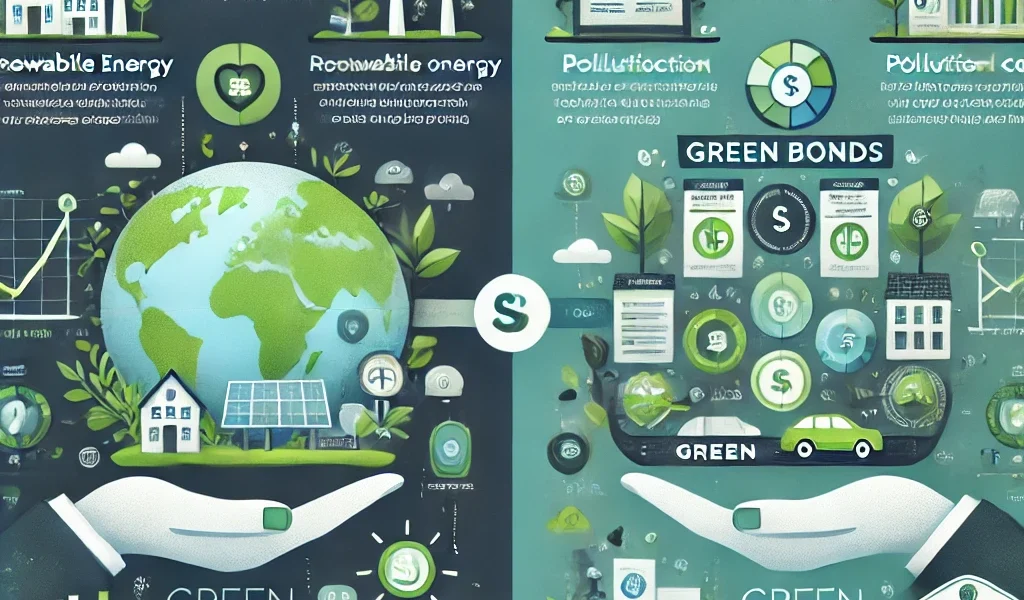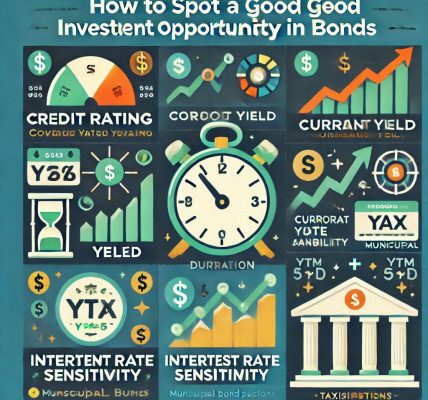s environmental concerns grow and the demand for sustainable investment options rises, green bonds have emerged as a powerful tool to finance projects that promote environmental sustainability. Investors are increasingly drawn to green bonds because they not only offer financial returns but also contribute to the development of projects that address climate change, renewable energy, and eco-friendly infrastructure.
In this comprehensive guide, we explore what green bonds are, how they work, their benefits, risks, and their growing impact on the bond market.
🎯 What Are Green Bonds?
💡 Definition of Green Bonds
Green bonds are fixed-income securities issued to finance projects that have a positive environmental impact. These bonds fund initiatives such as renewable energy, energy efficiency, pollution reduction, and climate change adaptation.
📝 How Do Green Bonds Work?
- Issuance: Governments, corporations, and financial institutions issue green bonds to raise capital for environmentally sustainable projects.
- Use of Proceeds: Funds raised through green bonds are earmarked exclusively for financing green projects.
- Transparency and Reporting: Issuers are required to disclose how the proceeds are allocated and provide impact reports to ensure transparency and accountability.
🌍 Types of Projects Financed by Green Bonds
- Renewable Energy Projects: Solar, wind, and hydroelectric power.
- Energy Efficiency Improvements: Smart grids, building upgrades, and industrial energy efficiency.
- Sustainable Waste Management: Recycling programs and waste-to-energy initiatives.
- Clean Transportation: Electric vehicles, public transit, and low-emission transport solutions.
- Water Conservation and Treatment: Projects aimed at improving water quality and conservation.
📊 Types of Green Bonds
1️⃣ Use-of-Proceeds Green Bonds
- The most common type where the funds are allocated exclusively to green projects.
- Example: Bonds issued to fund solar panel installations.
2️⃣ Green Revenue Bonds
- Backed by the revenue generated from the financed green projects.
- Example: Bonds where repayments come from the proceeds of a wind farm.
3️⃣ Green Project Bonds
- Issued to finance a specific green project, with investors assuming the project’s risks.
- Example: Bonds to fund a hydroelectric power plant.
4️⃣ Securitized Green Bonds
- Backed by a portfolio of green assets, such as mortgages on energy-efficient buildings.
- Example: Bonds secured by sustainable infrastructure projects.
✅ Benefits of Investing in Green Bonds
🌱 1. Promotes Environmental Sustainability
Investors in green bonds contribute to the funding of projects that promote sustainability, reduce carbon emissions, and mitigate climate change.
📈 2. Diversification and Portfolio Stability
Green bonds provide diversification benefits by offering exposure to environmentally focused assets that can enhance portfolio stability.
💸 3. Competitive Financial Returns
Green bonds offer returns similar to traditional bonds, allowing investors to achieve their financial objectives while supporting sustainable initiatives.
🔍 4. Positive Social Impact
Investing in green bonds aligns with the values of socially responsible investors (SRIs) and environmental, social, and governance (ESG)-focused portfolios.
📝 5. Transparency and Accountability
Green bond issuers must provide regular impact reports, ensuring transparency and demonstrating how the funds are being used.
❗ Risks Associated with Green Bonds
📉 1. Greenwashing Risk
Some issuers may label their bonds as “green” without adhering to strict environmental standards, leading to concerns about greenwashing.
🔄 2. Lack of Standardization
The green bond market lacks uniform global standards, making it difficult for investors to assess the authenticity of green projects.
💸 3. Interest Rate and Market Risks
Like traditional bonds, green bonds are subject to interest rate fluctuations and market volatility, which may affect their value.
🔍 4. Limited Liquidity
Green bonds may have lower trading volumes compared to traditional bonds, potentially affecting liquidity and ease of exit for investors.
📈 How Green Bonds Are Shaping the Bond Market
🌱 1. Growing Demand for Sustainable Investments
Investor demand for sustainable and socially responsible investments has driven the growth of the green bond market, encouraging issuers to incorporate ESG principles.
📊 2. Expansion of Green Bond Standards
Initiatives such as the Green Bond Principles (GBP) and the Climate Bonds Initiative (CBI) have introduced guidelines and certification standards to ensure transparency and accountability.
🔥 3. Increased Participation by Governments and Corporations
Governments worldwide are issuing green bonds to meet climate commitments, while corporations are leveraging green bonds to finance their sustainability goals.
🌍 4. Rise of ESG Integration in Fixed-Income Portfolios
Green bonds have fueled the adoption of ESG integration in fixed-income portfolios, allowing investors to align their values with their investment strategies.
📝 Comparing Green Bonds to Traditional Bonds
| Feature | Green Bonds | Traditional Bonds |
|---|---|---|
| Purpose | Finance environmental projects | General financing purposes |
| Transparency | High (impact reports required) | Moderate |
| Return on Investment | Similar to traditional bonds | Market-dependent |
| ESG Considerations | Strong focus on sustainability | Limited ESG focus |
| Regulatory Oversight | Varies by market and issuer | Established regulations |
🎯 How to Invest in Green Bonds
📈 1. Direct Investment in Green Bonds
Investors can purchase green bonds issued by governments, corporations, and financial institutions through brokerage accounts.
🔄 2. Green Bond ETFs and Mutual Funds
For diversified exposure to the green bond market, investors can opt for green bond ETFs or mutual funds that invest exclusively in green bonds.
🔎 3. Climate Bond Certification
Look for bonds certified by the Climate Bonds Initiative (CBI) to ensure adherence to global standards and impact reporting.
💡 4. Consider Risk and Yield
Evaluate the credit quality, interest rate sensitivity, and liquidity of green bonds to ensure alignment with your investment goals.
💸 Tax Implications of Green Bonds
✅ 1. Tax-Exempt Municipal Green Bonds
In the United States, municipal green bonds may offer tax-exempt interest income at the federal, state, and local levels.
📉 2. Capital Gains Tax
Capital gains from selling green bonds are subject to federal and state capital gains taxes, similar to traditional bonds.
💡 3. Tax Benefits for ESG Investors
Some jurisdictions offer tax incentives for investing in certified green projects, promoting sustainable investing.
🧠 Strategies for Integrating Green Bonds in Your Portfolio
📊 1. Diversify with Green Bond ETFs
Green bond ETFs provide exposure to a broad range of green bonds, offering diversification and reducing the risk associated with individual issuers.
🌱 2. Combine Green Bonds with Traditional Bonds
Balancing green bonds with traditional bonds ensures a mix of risk and return while incorporating sustainability into your fixed-income strategy.
🔎 3. Focus on Certified Green Bonds
To minimize the risk of greenwashing, prioritize investments in bonds that adhere to internationally recognized certification standards.
⚖️ Legal Considerations for Green Bonds
⚠️ 1. Avoid Misleading Claims
Ensure that the description of green bonds accurately reflects their environmental impact to avoid misleading investors.
⚠️ 2. Disclose Risks Transparently
Highlight the risks associated with green bonds, including credit risk, liquidity concerns, and the possibility of greenwashing.
⚠️ 3. Provide General Information, Not Investment Advice
Content should remain educational and avoid offering personalized investment recommendations.
📊 Summary: Key Takeaways
- Green bonds offer a unique opportunity to align financial goals with sustainability objectives by funding projects that promote environmental well-being.
- They provide competitive financial returns while allowing investors to contribute to global efforts to mitigate climate change.
- Despite challenges such as greenwashing and lack of standardization, the growth of the green bond market is shaping the future of sustainable investing.
- Investors can enhance their portfolios by integrating green bonds, diversifying their fixed-income holdings, and focusing on certified bonds to ensure authenticity.




